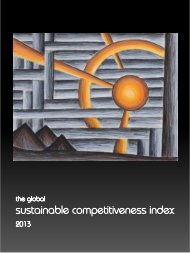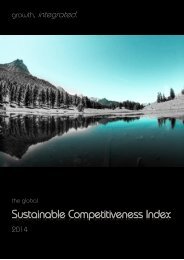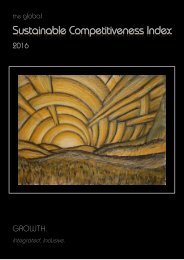The-Global-Sustainable-Competitiveness-Index-2015
You also want an ePaper? Increase the reach of your titles
YUMPU automatically turns print PDFs into web optimized ePapers that Google loves.
Summary<br />
<strong>Sustainable</strong><br />
Competitive<br />
Natural<br />
Capital<br />
Social<br />
Capital<br />
Intellectual<br />
Capital<br />
Resource<br />
Management<br />
Governance Spotlight Data<br />
3 Natural Capital<br />
<strong>The</strong> Natural Capital of a country is defined by the natural physical environment.<br />
<strong>The</strong> Natural Capital model incorporates the essence of resources available that<br />
allow a country to be completely self-sustaining: land, water, climate,<br />
biodiversity, food production and capacity, and energy and mineral resources.<br />
In addition, the level of depletion or degradation of those resources that could<br />
endanger future self-sufficiency are taken into account to reflect the full picture<br />
of the available natural capital.<br />
<strong>The</strong> number of data points related to natural capital available from a variety of<br />
sources is nearly endless. <strong>The</strong> main challenge is to select the most relevant and<br />
meaningful indicators amongst the wealth of available data. In order to define<br />
meaningful and relevant, the core issues affecting the sustainable use of natural<br />
capital have been defined in the natural capital model below:<br />
Natural capital indicators<br />
Key elements of<br />
competitiveness drivers in the<br />
Natural Capital Sub-<strong>Index</strong><br />
Based on the definition of the key natural capital areas, data series are chosen<br />
as indicators that reflect the sustainable competitiveness of a country based on<br />
its natural resources (natural capital).<br />
<strong>The</strong> indicators have been analysed for the latest data point available as well as<br />
their development over time, reflecting the current status and the future outlook<br />
of Natural Capital availability (environmental sustainability) in relation to the size<br />
and population of a country. In addition, indictors that measure the depletion or<br />
degradation of the natural resources have been taken into account. <strong>The</strong><br />
combination of these indicators reflect the current status as well as the ability to<br />
sustain the population and the national economy.<br />
As some of the above key areas are difficult to express in numerical values, some<br />
quantitative scores compiled by UN agencies have been used for certain<br />
indicators, such as biodiversity potential, resource depletion, and the ecological<br />
footprint.<br />
For the full list of indicators used, please refer to the methodology section.<br />
the sustainable competitiveness index <strong>2015</strong><br />
page 23








